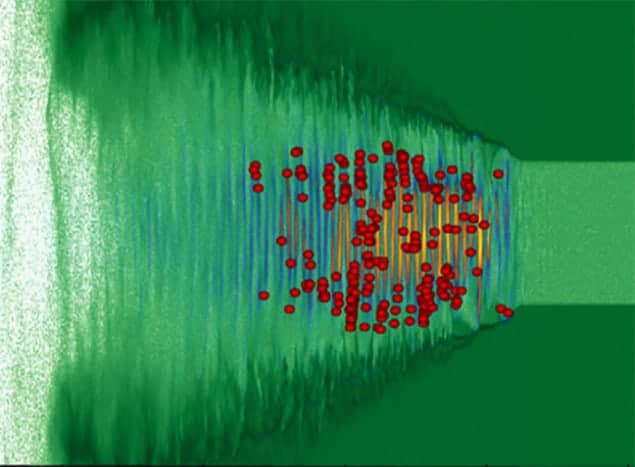
A collimated beam of gamma-ray photons could be created by firing intense laser pulses into a specially designed plastic target. That’s the claim of physicists at the University of Texas in Austin, US, whose computer simulations suggest that the electrons liberated when the pulse hits the target are accelerated in zigzag trajectories along magnetic-field lines. The electrons would therefore emit synchrotron radiation in the direction of the laser beam – an effect that could be used to make a pulsed gamma-ray source tens of terawatts in power.
Firing intense laser pulses at a target rips electrons from their constituent atoms, creating a plasma with a huge electric-field gradient that can be thousands of times greater than those generated by conventional particle accelerators. This gradient accelerates electrons to energies of several gigaelectronvolts, and now Alexey Arefiev and colleagues have shown that – under the right conditions – these electrons will emit synchrotron light at gamma-ray energies as they curve around the field lines of a very strong magnetic field.
The magnetic field is generated by the fast-moving electrons in the plasma, and the team’s computer simulations suggest that it can be as strong as 0.4 × 106 T. This is about 100,000 times stronger than the magnetic fields used during a medical magnetic-resonance-imaging (MRI) scan and is on a par with the magnetic field on the surface of a neutron star. Arefiev and colleagues say that the technique could be used to generate pulses of gamma rays with energies of several megaelectronvolts. The pulses could reach intensities of tens of terawatts and could be generated using existing petawatt pulsed lasers.
Straight and narrow
The simulations also suggest that building such a gamma-ray generator would involve big technical challenges. Under ideal conditions, the pulse should propagate through the plastic target in a straight line, creating a cylindrical region of plasma. In reality, however, some of the light and the accelerated electrons would deviate from the straight-line trajectory, creating gamma rays emitted in a “spray” across a number of different angles, rather than in a collimated beam.
Based on their simulations, Arefiev and colleagues suggest that this deviation could be minimized by creating channels in the target that have optical properties that prevent the light from being deflected. Potential applications for laser-driven gamma-ray beams include generating positrons via pair production; simulating astrophysical processes in the laboratory; nuclear spectroscopy; and medical applications such as therapy and surgery.
The research is described in Physical Review Letters.



